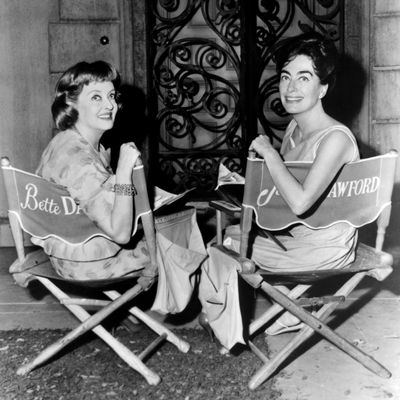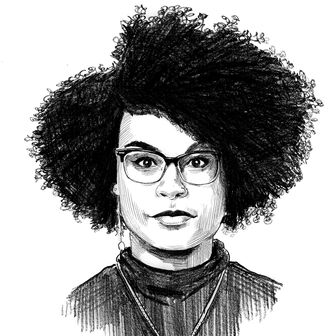
Earlier this month, FX announced that veteran TV producer Ryan Murphy will be doing a new anthology series for the network, Feud, which, in its first season, will detail the rivalry between Hollywood legends Bette Davis and Joan Crawford when they co-starred in the 1962 horror film Whatever Happened to Baby Jane? The news has been met with a lot of buzz, and for good reason. It sits perfectly in Murphy’s wheelhouse, with its campy potential and powerful female leads, and the cast is already capturing people’s imaginations: Jessica Lange is re-teaming with Murphy to bring Crawford to life while Susan Sarandon will co-star as Davis. Stanley Tucci will play infamous Warner Bros. head Jack Warner, with whom Davis had her own feud, Judy Davis stars as the influential gossip columnist Hedda Hopper, and Alfred Molina plays director of Baby Jane Robert Aldrich. But is Ryan Murphy the right man to bring these dynamic women to the screen?
There was near-unanimous praise for his latest anthology series, The People v. O.J. Simpson, which many pointed to as a sign of his growth and maturity as a creator and showrunner of television. But it’s important to keep in mind that while Murphy executive-produced O.J. and directed four episodes, he wasn’t a writer. It was created by the team of Scott Alexander and Larry Karaszewski, who developed and co-wrote the series*. That doesn’t mean Murphy doesn’t deserve credit for the series’ success, but attributing it primarily to him or taking it to mean he’s outgrown many of his issues as a writer is premature.
On the surface, Murphy seems interested in the interior lives of women. He often casts amazing older actresses who no longer get the film roles they deserve, like Lange, who headlined three seasons of American Horror Story, Angela Bassett, and Kathy Bates. But taking a closer look at Murphy’s treatment of women makes me nervous about how he’ll handle Crawford and Davis. The shows Murphy has a direct hand in writing can lean on sexual violence, and often make the older women seem like emptily campy figures meant to be funny rather than empathized with. American Horror Story: Coven, which misunderstands the fear of aging and the way it affects women’s relationships with themselves and one another is perhaps the greatest example of Murphy’s shortcomings when it comes to writing women. Maybe the fact that Feud is based on a true story will offset these tendencies. But Davis and Crawford, especially the latter (thanks to Mommie Dearest, which greatly warped her legacy), are frequently used as camp punch lines, and the camp factor is undoubtedly a draw for Murphy here. To understand why Murphy’s involvement raises an eyebrow, you have to know the history of the feud between Crawford and Davis.
At the top of their game, Davis and Crawford ruled Hollywood. Both were professionals: brave, fiery, and keen artists known for very different things. Crawford was an excellent businesswoman who understood how to shift her looks to reflect the modern woman in her four-decade career. She’s known for being beautiful rather than a great actress, even though she was one — just check out her 1945 Oscar-winning performance for Mildred Pierce. If Crawford was praised for her sex appeal, physicality, and beauty, Davis was revered for her skills as an actress, while her looks were wrongly disparaged. Davis was the first person to be nominated for ten Academy Awards, winning two in her career, and one of the most entrancing actors Hollywood has even seen.
So was this feud sparked by professional jealousy, considering each woman was praised for the same thing the other was criticized for? The reasons are complicated, but it all started in the mid-1930s due to a more prosaic one: a man.
The man in question was actor Franchot Tone, who is a debonair legend in his own right. As a stage actor from New York, he was more interested in theater than in film. In 1935, Davis co-starred with Tone in the drama Dangerous and she quickly fell for him. “I fell in love with Franchot, professionally and privately,” she once said. “Everything about him reflected his elegance, from his name to his manners.” But it’s Crawford whom Tone fell for. “He was madly in love with her,” Davis admitted. “They met each day for lunch … he would return to the set, his face covered in lipstick … He was honoured this great star was in love with him. I was jealous of course.”
Crawford and Tone married right after Dangerous wrapped, and although their marriage lasted only a few years, they stayed in each other’s lives. If Tone was the only thing to come between them, I don’t think Crawford and Davis’s feud would have lasted such a long time or become so venomous. Both women put their careers first, and, like any actress (especially those who actually get to the top), struggled to find their equilibrium in an industry that didn’t always respect them. Maybe they would have continued coolly sniping at each other in the press, trading insults like this one Crawford aimed at Davis: “Miss Davis was always partial to covering up her face in motion pictures. She called it ‘art.’ Others might call it camouflage — a cover-up for the absence of any real beauty.” Or the one Davis famously said: “[Crawford] slept with every male star at MGM, except Lassie.” It’s when the rivalry translated over into their careers that the real drama began.
At the beginning, because Davis and Crawford were at different studios they weren’t exactly fighting for the same roles, given that actors worked primarily in-house for their parent companies. (Which doesn’t mean professional rivalries didn’t flare up between actors working at competing studios.) Crawford came up the ranks at Hollywood’s glitziest studio, MGM. During their early incarnations (which ended in the 1960s), studios were enclosed universes that owned their stars with draconian contracts. Bette Davis was a Warner Brothers star. Unlike Crawford, she wasn’t afraid to take up issues with the studio when she felt she wasn’t getting the roles she deserved.
But in 1943, Crawford left MGM and signed with Warner Brothers, putting the women in direct competition. Two years later, Crawford starred in Mildred Pierce — a role Davis turned down — and won an Oscar for her performance, no doubt adding fuel to the fire.
While they continued to work and produce great performances, Hollywood has never been kind to women who age. Davis ended her tenure with Warner Brothers with the overheated Beyond the Forest, which received scathing reviews. Each woman went freelance as the studio system turned to rot and a genre they excelled in — the women’s picture — more or less ceased to be. They were still excellent in 1950s films like All About Eve, The Star, Sudden Fear, and Autumn Leaves. But their options were dwindling, which is when Whatever Happened to Baby Jane? entered the picture.
The 1962 film spawned the “hagsploitation” genre, which gave older actresses the opportunity to play dramatically different roles, framed within a horror-film context. On one hand, this allowed actresses to be unencumbered by having to be beautiful or tame or even likable. There’s a thrill in seeing these women shriek and slash their way across the screen. On the other, the films seem to look down upon these women, sometimes even condescendingly framing them as repulsive, even if the performances themselves brought a sense of empathy.
In Baby Jane, Crawford and Davis play sisters isolated from the world in their Hollywood mansion. Crawford plays the wheelchair-bound Blanche, whose career as an actress flourished while her sister’s life and career fell apart. Davis plays the Medusa-like figure of Jane — caked with makeup, dressed up as a demented doll. She’s unable to let go of her childhood, when she had fame as a vaudeville performer only to grow up and watch her sister find the success she wanted so desperately. (The film works partially because of the meta quality Crawford and Davis bring to it.)
Behind the scenes on Jane, the two found nasty ways to get under each other’s skin. Crawford was married to the CEO of Pepsi at the time, so Davis had a Coca-Cola machine installed in her dressing room. Crawford put rocks in her pockets when Davis was required to drag her across the floor onscreen. Davis gleefully speaks of enjoying pushing Crawford down the stairs for a scene. They proudly slung barbs at each other in the press.
But underneath all this, they were also artists who loved the work they did, showed up on time, and didn’t let their rivalry derail the film. In her memoir This ‘N That, Davis writes, “Joan was a pro. […] I always thank her for giving me the opportunity to play the part of “Baby Jane” Hudson.” It was Crawford who came up to Davis backstage after her performance in the 1961 Broadway play Night of the Iguana with the idea to adapt the novel on which Baby Jane is based. These women may not have liked or even truly respected each other, but they knew a meaty role when they saw it. Crawford approaching Davis underscores how smart she was as a businesswoman and a star, knowing the buzz that would surround seeing these two women legitimately attack each other onscreen, given their history.
The film was a financial and critical hit that revitalized their careers, and Davis earned her last Academy Award nomination for the film. Crawford was not nominated and responded in perhaps the most underhanded, petty way possible: She contacted the other nominees and offered to accept the award for them if they won. For whatever reason, they agreed. Davis may have been certain she’d win, but it was Anne Bancroft’s name that was called, and Crawford who accepted the Oscar on her behalf. Davis was livid, later saying, “I almost dropped dead! I was paralyzed with shock. To deliberately upstage me like that — her behavior was despicable.”
Davis and Crawford were set to star in another, Aldrich-directed hagsploitation film, Hush … Hush Sweet Charlotte. But Crawford dropped out and the role was given to Davis’s longtime friend and legend in her own right (with her own storied feud), Olivia de Havilland. In the end, Davis got the last word when Crawford died first, in 1977. “You should never say bad things about the dead, only good,” she said. “Joan Crawford is dead … Good!”
This is the popular image of Davis and Crawford. But we also have pictures of the two of them on the set of Baby Jane or during the pre-production of Hush … Hush that show them laughing together. They’re striking for how human they appear, when they’re typically framed as anything but. And if you look at the context surrounding their petty warring, the more interesting story is the one about how women are cast aside when they age, and the ways artistic women are undone by their own ambition. Their rivalry asks interesting questions about stardom and the value of older women in a culture that doesn’t see their humanity. There has never been a star quite like Crawford. There will never again be an actress who understands female anger and transformation like Davis. Given the blunt, campy, and often emotionally void way Murphy handles the story lines he gives the many great older actresses he casts, will he be able to go beyond the gossip and camp factor to see the women underneath the legends?
* An earlier version of this piece stated that Scott Alexander and Larry Karaszewksi wrote all ten episodes of The People v. O.J. Simpson. In fact, they wrote five episodes.





